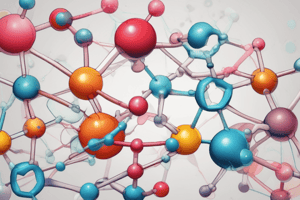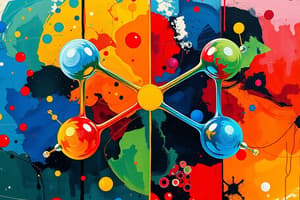Podcast
Questions and Answers
How are compounds A and B related to each other?
How are compounds A and B related to each other?
diastereomers
How are compounds A and C related to each other?
How are compounds A and C related to each other?
constitutional isomers
How are compounds B and D related to each other?
How are compounds B and D related to each other?
identical
How are compounds A and D related to each other?
How are compounds A and D related to each other?
Which compounds would be optically active?
Which compounds would be optically active?
Which compounds have a plane of symmetry?
Which compounds have a plane of symmetry?
Which compound(s) is/are meso compound(s)?
Which compound(s) is/are meso compound(s)?
Identify any strain present in the following Newman projections.
Identify any strain present in the following Newman projections.
How many 1H NMR signals does each compound give?
How many 1H NMR signals does each compound give?
What is the molecular formula of a hydrocarbon with two degrees of unsaturation and all unique carbons?
What is the molecular formula of a hydrocarbon with two degrees of unsaturation and all unique carbons?
Match the compound to its aromatic splitting pattern: A-B; B-C; C-A
Match the compound to its aromatic splitting pattern: A-B; B-C; C-A
Flashcards
Constitutional Isomers
Constitutional Isomers
Compounds that have the same molecular formula but different connectivity of atoms. Think of them as having the same ingredients but arranged differently.
Stereoisomers
Stereoisomers
Compounds with the same molecular formula but different spatial arrangements of atoms. These are further divided into enantiomers and diastereomers.
Enantiomers
Enantiomers
Special type of stereoisomers that are non-superimposable mirror images of each other, like left and right hands.
Diastereomers
Diastereomers
Signup and view all the flashcards
Chirality
Chirality
Signup and view all the flashcards
Conformers
Conformers
Signup and view all the flashcards
Newman Projection
Newman Projection
Signup and view all the flashcards
Chair Conformer
Chair Conformer
Signup and view all the flashcards
NMR Spectroscopy
NMR Spectroscopy
Signup and view all the flashcards
Mass Spectrometry
Mass Spectrometry
Signup and view all the flashcards
IR Spectroscopy
IR Spectroscopy
Signup and view all the flashcards
Study Notes
Isomers and Stereoisomers
- Compounds can be related to each other as identical, enantiomers, diastereomers, or constitutional isomers
- Enantiomers and diastereomers are types of stereoisomers
Stereoisomers and Chirality
- A compound can have multiple stereoisomers, and each stereoisomer can be assigned as R or S at the stereogenic center(s)
- Chiral molecules can be optically active, while achiral molecules cannot
- Molecules with a plane of symmetry are achiral
Conformers and Energy Diagrams
- Rotating a molecule around a bond can create different conformers
- Energy diagrams can be created to show the relative energy of each conformer
Newman Projections and Chair Conformers
- Newman projections can be converted to chair conformers
- Chair conformers can undergo ring flip to show equilibrium between conformers
Isomeric Compounds
- Isomeric compounds can be dimethylcyclopentanes, each with different properties
- Compounds can be compared based on their boiling points, chirality, and presence of a plane of symmetry
Strain in Molecules
- Strain can be present in molecules, which can be identified through Newman projections
NMR Spectroscopy
- NMR spectroscopy can be used to determine the number of 1H NMR signals a compound gives
- The number of 1H NMR signals can be used to determine the molecular structure
Molecular Formula
- A molecular formula can be used to determine the structure of a compound
- A hydrocarbon with two degrees of unsaturation can have a specific molecular formula
Aromatic Splitting Patterns
- Constitutional isomers can have different aromatic splitting patterns
- Matching a compound to its aromatic splitting pattern can be used to identify the structure
Mass Spectroscopy
- Mass spectra can be used to suggest properties of a molecule
- Mass spectra can be used to identify the structure of a compound
IR Spectroscopy
- IR spectroscopy can be used to match a compound to its IR spectrum
- IR spectroscopy can be used to identify the structure of a compound
Spectroscopic Data
- Spectroscopic data, including NMR, can be used to determine the structure of a compound
- A combination of spectroscopic data can be used to determine the structure of a compound
Studying That Suits You
Use AI to generate personalized quizzes and flashcards to suit your learning preferences.




